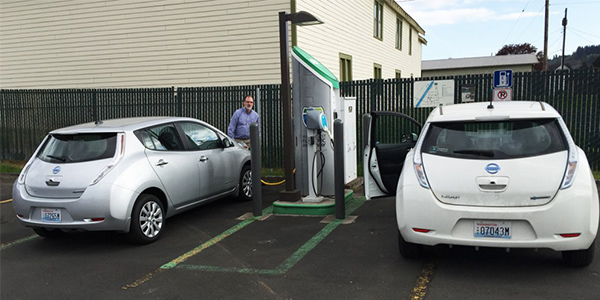Infrastructure is the main concern facing two Washington bills that propose to switch the state’s auto market to only electric vehicles by 2030.
Will there be enough generation? Who will install and pay for all the charging stations? Can the Northwest power grid transmit enough energy to handle all those vehicles?
“We’re going to need hundreds of thousands of charging ports for millions of vehicles,” Douglas Warren, a lobbyist for Douglas and Klickitat counties’ public utility districts, said at a Washington House Transportation Committee hearing Feb. 1.
State Rep. Nicole Macri (D) and Sen. Marko Liias (D) introduced similar bills this session to require that the Washington State Transportation Commission adopt regulations by 2025 mandating that all model year 2030 and later passenger and light-duty vehicles sold in the state be EVs. The two bills would require the commission to provide the legislature a plan for developing the regulations by Sept. 1, 2023.
“We’re trying to phase this in. We’re trying to be thoughtful,” Liias said.
This is the second year that Macri has submitted the proposal as a bill. It did not make it out of the House Transportation Committee in 2020. This year, Liias introduced a companion bill in the Senate.
“We’re presenting this bill because of the urgent needs of dealing with climate change,” Macri said.
Macri and Liias both pointed to General Motors’ recent announcement that it plans to manufacture mostly electric vehicles by 2035. Macri also cited Volvo and Volkswagen introducing their first electric vehicles in the last few years. The private sector is already beginning a transition to EVs because of pollution concerns, they concluded.
“Transportation is the largest source of emissions in the state. Everyone knows we’re headed this way,” Liias said.
Pierce County Councilor Ryan Mello, speaking on behalf of himself, told the committee that the marketplace has begun to gradually transition to EVs on its own, and that the state government needs to send a strong signal to manufacturers to encourage that change.
‘Wishful Thinking’
At the hearing, several questions addressed the infrastructure issue, which both Macri and Liias acknowledged is a major hurdle.
“No one knows what the fiscal impact of this bill will cost. … There seems to be variables on top of variables on top of variables in this bill,” Rep. Jim Walsh (R) said.
“We need a statewide analysis,” Warren said. Nick Garcia, policy director for the Washington Public Utility Districts Association, said a massive investment in Washington’s power grid will be necessary to sustain EV culture.
Macri contended that having a locked-in date is needed to give the marketplace good information on how to adjust and give the state government a timetable to get infrastructure constructed. “2030 is still a long way off,” she said.
Scott Hazelgrove, representing the Washington State Auto Dealers Association, noted that his organization opposed Macri’s bill last year but is neutral in this session and hopes to work with the representative on the details. A deadline for making changes could be a useful tool in helping his constituents deal with switchovers to EVs, he said.
“A 100% EV rate in Washington approaches wishful thinking,” argued Jessica Spiegel, Northwest regional director for the Western States Petroleum Association.
Rep. Ed Orcutt (R) asked, “What if we get to 2030, and there’s not a big enough supply of EVs, will there be exceptions?”


